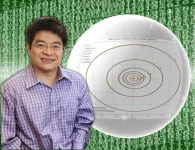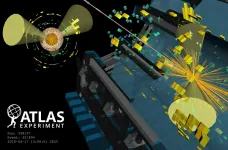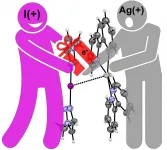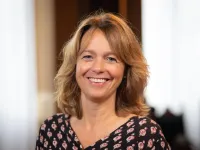(Press-News.org) A novel computer algorithm, or set of rules, that accurately predicts the orbits of planets in the solar system could be adapted to better predict and control the behavior of the plasma that fuels fusion facilities designed to harvest on Earth the fusion energy that powers the sun and stars.
The algorithm, devised by a scientist at the U.S. Department of Energy's (DOE) Princeton Plasma Physics Laboratory (PPPL), applies machine learning, the form of artificial intelligence (AI) that learns from experience, to develop the predictions. "Usually in physics, you make observations, create a theory based on those observations, and then use that theory to predict new observations," said PPPL physicist Hong Qin, author of a paper detailing the concept in Scientific Reports. "What I'm doing is replacing this process with a type of black box that can produce accurate predictions without using a traditional theory or law."
Qin (pronounced Chin) created a computer program into which he fed data from past observations of the orbits of Mercury, Venus, Earth, Mars, Jupiter, and the dwarf planet Ceres. This program, along with an additional program known as a "serving algorithm," then made accurate predictions of the orbits of other planets in the solar system without using Newton's laws of motion and gravitation. "Essentially, I bypassed all the fundamental ingredients of physics. I go directly from data to data," Qin said. "There is no law of physics in the middle."
The program does not happen upon accurate predictions by accident. "Hong taught the program the underlying principle used by nature to determine the dynamics of any physical system," said Joshua Burby, a physicist at the DOE's Los Alamos National Laboratory who earned his Ph.D. at Princeton under Qin's mentorship. "The payoff is that the network learns the laws of planetary motion after witnessing very few training examples. In other words, his code really 'learns' the laws of physics."
Machine learning is what makes computer programs like Google Translate possible. Google Translate sifts through a vast amount of information to determine how frequently one word in one language has been translated into a word in the other language. In this way, the program can make an accurate translation without actually learning either language.
The process also appears in philosophical thought experiments like John Searle's Chinese Room. In that scenario, a person who did not know Chinese could nevertheless "translate" a Chinese sentence into English or any other language by using a set of instructions, or rules, that would substitute for understanding. The thought experiment raises questions about what, at root, it means to understand anything at all, and whether understanding implies that something else is happening in the mind besides following rules.
Qin was inspired in part by Oxford philosopher Nick Bostrom's philosophical thought experiment that the universe is a computer simulation. If that were true, then fundamental physical laws should reveal that the universe consists of individual chunks of space-time, like pixels in a video game. "If we live in a simulation, our world has to be discrete," Qin said. The black box technique Qin devised does not require that physicists believe the simulation conjecture literally, though it builds on this idea to create a program that makes accurate physical predictions.
The resulting pixelated view of the world, akin to what is portrayed in the movie The Matrix, is known as a discrete field theory, which views the universe as composed of individual bits and differs from the theories that people normally create. While scientists typically devise overarching concepts of how the physical world behaves, computers just assemble a collection of data points.
Qin and Eric Palmerduca, a graduate student in the Princeton University Program in Plasma Physics, are now developing ways to use discrete field theories to predict the behavior of particles of plasma in fusion experiments conducted by scientists around the world. The most widely used fusion facilities are doughnut-shaped tokamaks that confine the plasma in powerful magnetic fields.
Fusion, the power that drives the sun and stars, combines light elements in the form of plasma -- the hot, charged state of matter composed of free electrons and atomic nuclei that represents 99% of the visible universe -- to generate massive amounts of energy. Scientists are seeking to replicate fusion on Earth for a virtually inexhaustible supply of power to generate electricity.
"In a magnetic fusion device, the dynamics of plasmas are complex and multi-scale, and the effective governing laws or computational models for a particular physical process that we are interested in are not always clear," Qin said. "In these scenarios, we can apply the machine learning technique that I developed to create a discrete field theory and then apply this discrete field theory to understand and predict new experimental observations."
This process opens up questions about the nature of science itself. Don't scientists want to develop physics theories that explain the world, instead of simply amassing data? Aren't theories fundamental to physics and necessary to explain and understand phenomena?
"I would argue that the ultimate goal of any scientist is prediction," Qin said. "You might not necessarily need a law. For example, if I can perfectly predict a planetary orbit, I don't need to know Newton's laws of gravitation and motion. You could argue that by doing so you would understand less than if you knew Newton's laws. In a sense, that is correct. But from a practical point of view, making accurate predictions is not doing anything less."
Machine learning could also open up possibilities for more research. "It significantly broadens the scope of problems that you can tackle because all you need to get going is data," Palmerduca said.
The technique could also lead to the development of a traditional physical theory. "While in some sense this method precludes the need of such a theory, it can also be viewed as a path toward one," Palmerduca said. "When you're trying to deduce a theory, you'd like to have as much data at your disposal as possible. If you're given some data, you can use machine learning to fill in gaps in that data or otherwise expand the data set."
INFORMATION:
Support for this research came from the DOE Office of Science (Fusion Energy Sciences).
PPPL, on Princeton University's Forrestal Campus in Plainsboro, N.J., is devoted to creating new knowledge about the physics of plasmas -- ultra-hot, charged gases -- and to developing practical solutions for the creation of fusion energy. The Laboratory is managed by the University for the U.S. Department of Energy's Office of Science, which is the single largest supporter of basic research in the physical sciences in the United States and is working to address some of the most pressing challenges of our time.
For more information, visit https://energy.gov/science
Monash University researchers have uncovered the barrier to β-cell (beta cell) regeneration that could pave the way for improved treatments for diabetes and diseases that involve organ and tissue damage.
The human body doesn't repair itself very well, with our liver the only organ that can regenerate efficiently. We have limited capacity to regenerate new cells or tissue after birth as the genes involved in development are switched off.
This process happens through DNA methylation, a biological process where chemicals (methyl groups) are written on DNA and modify the way the gene functions. ...
A team of researchers at Lawrence Berkeley National Laboratory (Berkeley Lab) used a quantum computer to successfully simulate an aspect of particle collisions that is typically neglected in high-energy physics experiments, such as those that occur at CERN's Large Hadron Collider.
The quantum algorithm they developed accounts for the complexity of parton showers, which are complicated bursts of particles produced in the collisions that involve particle production and decay processes.
Classical algorithms typically used to model parton showers, such ...
An international research team led by Professor Kari Rissanen of the University of Jyvaskyla (Finland) and Professor Antonio Frontera of the University of Balearic Islands (Spain) has demonstrated that positively charged iodine (termed iodonium) is able to favorably interact with a silver cation (Ag+), overcoming the strong electrostatic repulsion. The research was published online in Chem -journal 8th of February 2021.
It is well known and intuitive that iodide (I-) has a strong affinity for Ag+. For instance, AgI is one of the most insoluble inorganic salts ...
When we listen to speech sounds, the information that enters our left and right ear is not exactly the same. This may be because acoustic information reaches one ear before the other, or because the sound is perceived as louder by one of the ears. Information about speech sounds also reaches different parts of our brain, and the two hemispheres are specialised in processing different types of acoustic information. But how does the brain integrate auditory information from different areas?
To investigate this question, lead researcher Basil Preisig from the University of Zurich collaborated with an international team of scientists. In an earlier study, the team discovered that the brain integrates information about speech sounds by 'balancing' the rhythm of gamma waves across ...
Most countries introduced school closures during the spring of 2020 despite substantial uncertainty regarding the effectiveness in containing SARS-CoV-2. In Sweden, upper-secondary schools moved online while lower-secondary schools remained open. A comparison of parents with children in the final year of lower-secondary and first year of upper-secondary school shows that keeping the former open had limited consequences for the overall transmission of the virus. However, the infection rate doubled among lower-secondary teachers relative to upper-secondary ones. The infection rate among partners of lower-secondary teacher was 30 percent higher than among their upper-secondary counterparts.
On March 18, 2020, Swedish ...
T lymphocytes, or T cells, are an important component of our immune system. They can recognize foreign proteins, so-called antigens, as peptide fragments - for instance, those derived from viruses or cancer cells. In principle, they could, but usually do not, attack our own ('self') proteins. "That is why it is important for the organism to tightly control the activities of T cells," says Dr. Reinhard Obst, head of a research group at the Institute for Immunology at LMU's Biomedical Center that studies the activation of T cells. The project contributed to the Collaborative Research Center 1054 that explores the plasticity of cell fate decisions in the immune system.
When ...
Scientists use many different tests to investigate what happens in the brain in people experiencing stress. It is unclear to what extent the various methods with which subjects are placed under stress are comparable to each other. In a meta-analysis, a biopsychology team from Ruhr-Universität Bochum compared 31 previous studies that had investigated stress using functional magnetic resonance imaging (fMRI). The team worked out which regions of the brain are activated as standard during stress and which stress tests trigger similar activation patterns. They describe the results in the journal Neuroscience and Biobehavioral Reviews, published online on 5 February 2021.
To conduct the work, ...
The move from the ancient system of £sd coinage to 100p to £1 was controversial, considered by some to be a sign of the UK's receding importance on the world stage and even as the beginning of the tumultuous relationship with Europe that ultimately led to Brexit.
But as a result of extensive analysis of a quiet backwater of recent history, Andy argues that the move towards decimalisation had little to do with Europe and in fact was a traditional British compromise.
"It was an event that I remember from my youth, but I found that ...
Biomarkers play a central role in the diagnosis of disease and assessment of its course. Among the markers now in use are genes, proteins, hormones, lipids and other classes of molecules. Biomarkers can be found in the blood, in cerebrospinal fluid, urine and various types of tissues, but most of them have one thing in common: They occur in extremely low concentrations, and are therefore technically challenging to detect and quantify.
Many detection procedures use molecular probes, such as antibodies or short nucleic-acid sequences, which are designed to bind to specific biomarkers. When a probe recognizes and binds to its target, chemical or physical reactions give rise to fluorescence signals. Such methods work well, provided they are sensitive enough to recognize ...
Knowledge on how cells communicate is an important key to understanding many biological systems and diseases. A research team led by researchers at the University of Gothenburg has now used a unique combination of methods to map the mechanism behind cellular communication. Their findings can potentially improve understanding of the underlying mechanism behind type 2 diabetes.
We know that human communication is important, but communication between the cells in our bodies is just as vital. The processes where cells synchronize and coordinate their behaviour is required for an organism to function and for human organs to be able to perform their functions.
"How do cells go from monologues ...







